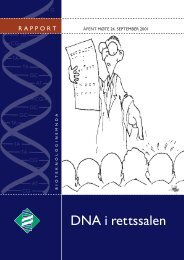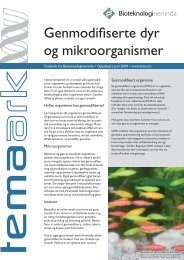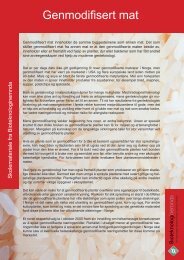Fiskevaksiner og genteknologi â Internseminar - Bioteknologinemnda
Fiskevaksiner og genteknologi â Internseminar - Bioteknologinemnda
Fiskevaksiner og genteknologi â Internseminar - Bioteknologinemnda
- No tags were found...
You also want an ePaper? Increase the reach of your titles
YUMPU automatically turns print PDFs into web optimized ePapers that Google loves.
<strong>Fiskevaksiner</strong> <strong>og</strong> genteknol<strong>og</strong>igene will produce, but the plasmid can’t replicate.How is it produced? You have your gene, you stickit on your plasmid, you put it into bacteria, generallyE. coli, you grow it up, and then you purify it so it’s justa pure plasmid, clean of all other contaminants. Thenyou take it out and you vaccinate the fish with it.Results of DNA vaccinesI’m not going to show you a lot of results, but I amjust going to show you one example that shows youthe type of good results you can get. I could also showyou a lot of bad results, because as I said, this is nota magic bullet, this is a technique just like all othertechniques in vaccine development and everythingelse. Sometimes, with some organisms it works, orwith some genes it works, for some it does not. It takesa lot of time, and it is not a magic bullet.Typical good results (see figure): This is simplya little bit of data that shows intramuscular vs.intraperitoneal vaccination. The Y-axis shows howmany fish have died in the challenge. In the first threecases, you have vaccinated the fish with increasingamounts of DNA vaccine, in this case into the muscle;the fourth case is a control plasmid without your geneof interest injected into the muscle, where you get50% dying, whereas with a DNA vaccine you havevery few dying. In the fifth case, you have inactivatedvirus injected into the muscle. Normally in a vaccineyou do not inject inactivated virus into the muscle, youformulate it in a proper formulation and it goes intothe cavity here. So this just shows you what happenswhen you have an inactivated virus: again, it hasvery little protection. And the sixth case is if you justtake naked DNA and put it into the peritoneal cavity,again without formulation, without oils, withoutanything else: you get some protection, but not asgood as by putting it into the muscle. And this is quitecommon, both in fish and in mammals, that one ofthe best methods for delivering vaccines today is stillintramuscular.Unique features of DNA vaccines- No risk for infection, there is nothing alive.- You raise antibodies or an immunol<strong>og</strong>ical responseagainst the native forms of the proteins.- You raise T-cell response, which is again animmunol<strong>og</strong>ical response- You can raise long lived responses; again with fish,we are talking about fish that are alive for two years,so we don’t need a vaccine that lasts 40 years, we needa vaccine that lasts 2 years.- Good stability at low and high temperatures. As apure piece of DNA, DNA is very stable, you can do alot with it and nothing happens to it.- And of course it is very easy to use a combination ofvaccines for a combination of proteins.Limitations of DNA vaccinesI have talked about a gene of interest. Basically, themajor limitation to DNA vaccines is that it is limitedto proteins. Often the best immunol<strong>og</strong>ical responseagainst a path<strong>og</strong>enic bacterium is in fact raised byvery complex molecules, for example a protein thathas been modified and has extra sugars and all sortsof different modifications put on it. In the path<strong>og</strong>enicbacteria, there are many gene products responsiblefor modifying the components.These compleximmun<strong>og</strong>enic molecules can be easy to isolate; eitheryou can use a whole bacteria, or isolate componentsof the cell wall, for example, and that componentwould give a very nice immunol<strong>og</strong>ical response. But toprovide the cell with the same complex immun<strong>og</strong>enicmolecule, in the form of a DNA vaccine, you wouldhave to stick a huge number of genes into the animalcell and you would have to hope that the animal cellgene expression machinery will work properly withall of these bacterial genes, turn them on and off at theright times and at the right levels, so that the animalcell will actually make the compound you are lookingfor. This would be a tremendously complex problem,scientifically, and probably will never be possible.So the major limitation for DNA vaccines, is thatthey are limited to a protein. If the major or the onlyimmunol<strong>og</strong>ical response is raised against something9
















